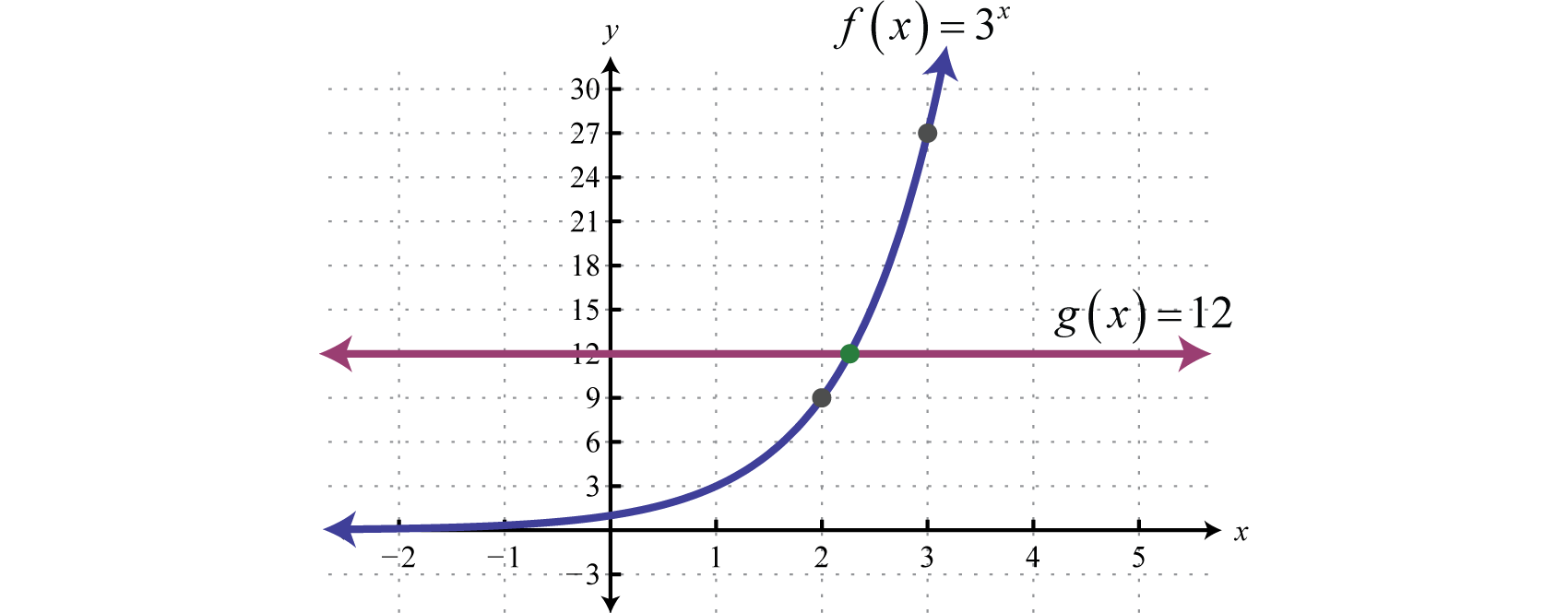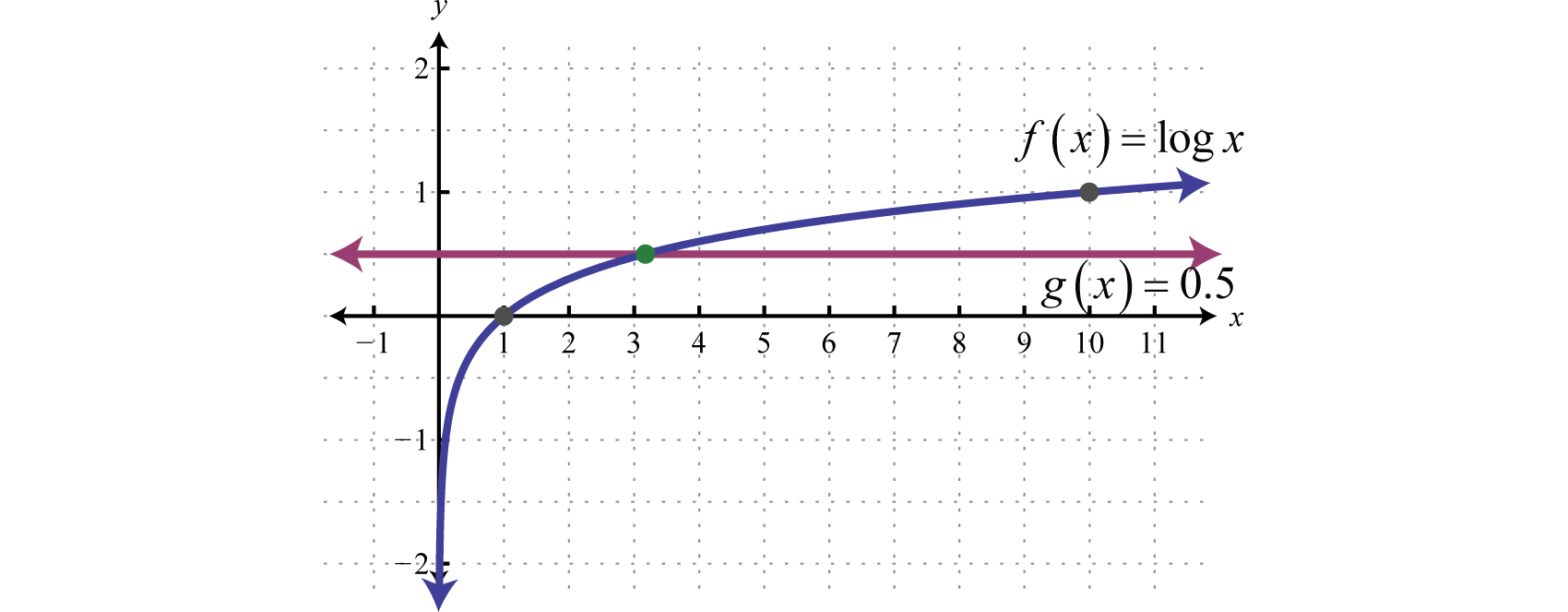An exponential equationAn equation which includes a variable as an exponent. is an equation that includes a variable as one of its exponents. In this section we describe two methods for solving exponential equations. First, recall that exponential functions defined by where and , are one-to-one; each value in the range corresponds to exactly one element in the domain. Therefore, implies The converse is true because f is a function. This leads to the very important one-to-one property of exponential functionsGiven and we have if and only if :
Use this property to solve special exponential equations where each side can be written in terms of the same base.
Solve:
Solution:
Begin by writing 27 as a power of 3.
Next apply the one-to-one property of exponential functions. In other words, set the exponents equal to each other and then simplify.
Answer: 2
Solve:
Solution:
Begin by writing 16 as a power of 2 and then apply the power rule for exponents.
Now that the bases are the same we can set the exponents equal to each other and simplify.
Answer:
In many cases we will not be able to equate the bases. For this reason we develop a second method for solving exponential equations. Consider the following equations:
We can see that the solution to should be somewhere between 2 and 3. A graphical interpretation follows.

To solve this we make use of fact that logarithms are one-to-one functions. Given the one-to-one property of logarithmsGiven and where we have if and only if follows:
This property, as well as the properties of the logarithm, allows us to solve exponential equations. For example, to solve apply the common logarithm to both sides and then use the properties of the logarithm to isolate the variable.
Approximating to four decimal places on a calculator.
An answer between 2 and 3 is what we expected. Certainly we can check by raising 3 to this power to verify that we obtain a good approximation of 12.
Note that we are not multiplying both sides by “log”; we are applying the one-to-one property of logarithmic functions — which is often expressed as “taking the log of both sides.” The general steps for solving exponential equations are outlined in the following example.
Solve:
Solution:
Step 1: Isolate the exponential expression.
Step 2: Take the logarithm of both sides. In this case, we will take the common logarithm of both sides so that we can approximate our result on a calculator.
Step 3: Apply the power rule for logarithms and then solve.
This is an irrational number which can be approximated using a calculator. Take care to group the numerator and the product in the denominator when entering this into your calculator. To do this, make use of the parenthesis buttons and :
Answer:
Solve:
Solution:
The exponential function is already isolated and the base is e. Therefore, we choose to apply the natural logarithm to both sides.
Apply the power rule for logarithms and then simplify.
Answer:
On most calculators there are only two logarithm buttons, the common logarithm and the natural logarithm If we want to approximate we have to somehow change this base to 10 or e. The idea begins by rewriting the logarithmic function , in exponential form.
Here and so we can apply the one-to-one property of logarithms. Apply the logarithm base b to both sides of the function in exponential form.
And then solve for y.
Replace y into the original function and we have the very important change of base formula; we can write any base-a logarithm in terms of base-b logarithms using this formula.:
We can use this to approximate as follows.
Notice that the result is independent of the choice of base. In words, we can approximate the logarithm of any given base on a calculator by dividing the logarithm of the argument by the logarithm of that given base.
Approximate the nearest hundredth.
Solution:
Apply the change of base formula and use a calculator.
On a calculator,
Answer: 2.46
Try this! Solve: Give the exact and approximate answer rounded to four decimal places.
Answer:
A logarithmic equationAn equation that involves a logarithm with a variable argument. is an equation that involves a logarithm with a variable argument. Some logarithmic equations can be solved using the one-to-one property of logarithms. This is true when a single logarithm with the same base can be obtained on both sides of the equal sign.
Solve:
Solution:
We can obtain two equal logarithms base 2 by adding to both sides of the equation.
Here the bases are the same and so we can apply the one-to-one property and set the arguments equal to each other.
Checking in the original equation:
Answer: 3
When solving logarithmic equations the check is very important because extraneous solutions can be obtained. The properties of the logarithm only apply for values in the domain of the given logarithm. And when working with variable arguments, such as , the value of x is not known until the end of this process. The logarithmic expression is only defined for values
Solve:
Solution:
Apply the one-to-one property of logarithms (set the arguments equal to each other) and then solve for x.
When performing the check we encounter a logarithm of a negative number:
Try this on a calculator, what does it say? Here is not in the domain of Therefore our only possible solution is extraneous and we conclude that there are no solutions to this equation.
Answer: No solution, Ø.
Caution: Solving logarithmic equations sometimes leads to extraneous solutions — we must check our answers.
In many cases we will not be able to obtain two equal logarithms. To solve such equations we make use of the definition of the logarithm. If , where , then implies that Consider the following common logarithmic equations (base 10),
We can see that the solution to will be somewhere between 1 and 10. A graphical interpretation follows.

To find x we can apply the definition as follows.
This can be approximated using a calculator,
An answer between 1 and 10 is what we expected. Check this on a calculator.
Solve:
Solution:
Apply the definition of the logarithm.
Solve the resulting equation.
Check.
Answer: 7
In order to apply the definition, we will need to rewrite logarithmic expressions as a single logarithm with coefficient 1.The general steps for solving logarithmic equations are outlined in the following example.
Solve:
Solution:
Step 1: Write all logarithmic expressions as a single logarithm with coefficient 1. In this case, apply the product rule for logarithms.
Step 2: Use the definition and rewrite the logarithm in exponential form.
Step 3: Solve the resulting equation. Here we can solve by factoring.
Step 4: Check. This step is required.
Check |
Check |
|---|---|
In this example, is not in the domain of the given logarithmic expression and is extraneous. The only solution is
Answer: 4
Solve:
Solution:
Begin by writing all logarithmic expressions on one side and constants on the other.
Apply the quotient rule for logarithms as a means to obtain a single logarithm with coefficient 1.
This is a common logarithm; therefore use 10 as the base when applying the definition.
Check.
Answer: −5
Find the inverse:
Solution:
Begin by replacing the function notation with y.
Interchange x and y and then solve for y.
The resulting function is the inverse of f. Present the answer using function notation.
Answer:
Solve using the one-to-one property of exponential functions.
Solve. Give the exact answer and the approximate answer rounded to the nearest thousandth.
Find the x- and y-intercepts of the given function.
Use a u-substitution to solve the following.
(Hint: Let )
Use the change of base formula to approximate the following to the nearest hundredth.
If left unchecked, a new strain of flu virus can spread from a single person to others very quickly. The number of people affected can be modeled using the formula , where t represents the number of days the virus is allowed to spread unchecked. Estimate the number of days it will take 1,000 people to become infected.
The population of a certain small town is growing according to the function , where t represents time in years since the last census. Use the function to determine number of years it will take the population to grow to 25,000 people.
Solve using the one-to-one property of logarithms.
Solve.
Find the x- and y-intercepts of the given function.
Find the inverse of the following functions.
Solve.
In chemistry, pH is a measure of acidity and is given by the formula , where is the hydrogen ion concentration (measured in moles of hydrogen per liter of solution.) Determine the hydrogen ion concentration if the pH of a solution is 4.
The volume of sound, L in decibels (dB), is given by the formula where I represents the intensity of the sound in watts per square meter. Determine the intensity of an alarm that emits 120 dB of sound.
Research and discuss the history and use of the slide rule.
Research and discuss real-world applications involving logarithms.
4
3
−2, 1
, 3
Ø
x-intercept: ; y-intercept:
x-intercept: None; y-intercept:
x-intercept: None; y-intercept:
1
0,
2.32
−0.25
−3.32
1.16
Approximately 31 days
10
−2
, 3
1
13
−5
±3
13
8
2
9
Ø
x-intercept: ; y-intercept:
x-intercept: ; y-intercept: None
x-intercept: ; y-intercept:
55
1
Ø
moles per liter
Answer may vary